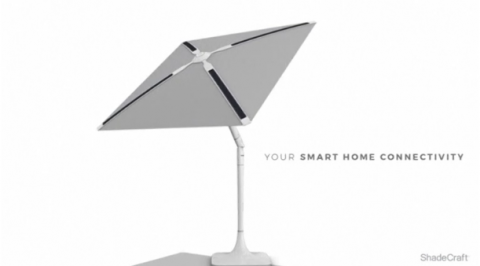

Reuters — An autonomous robotic parasol that tracks the sun and charges itself with integrated solar panels was demonstrated this week at the IFA consumer electronics fair in Berlin.
Developed by United States-based company Shadecraft, the Sunflower’s main purpose is to provide shade just like a regular parasol. But it is also packed with connected technology including a built-in security camera, a microphone, speakers, and lights.
Throughout the day the Sunflower follows the sun – just like an actual flower – providing constant shade for the user. This movement also means its four integrated solar panels are constantly in the optimal position to harvest the sun’s rays.
“Sunflower tracks the sun for optimal solar energy retention,” said Shadecraft founder and chief executive officer Armen Gharabegian. “It then transfers that to a whole series of attributes.”
He added that global positioning system keeps the Sunflower on track even when the sun isn’t shining: “In the past people have been tracking the sun through light sensors, and that’s not very efficient in cloudy weather. So we’re tracking the sun with astronomical data which is very accurate.”
The Sunflower powers itself entirely with about 30 percent of the energy it harvests, with the remaining power stored in batteries that can hold up to 72 hours of operating charge; useful for cloudy days when solar production may be reduced.
Weather-monitoring sensors keep tabs on inclement conditions, with the parasol retracting when the wind becomes too strong. Its sensors also monitor its surroundings to provide real-time health warnings to users, including air quality and UV levels.
“It’ll know how long you’ve been in the sun, it’ll recommend what days you should be there (in the sun) with on-board sensors; analysing UV, analysing a whole slew of different weather conditions,” added Gharabegian.
A prototype Sunflower was first unveiled at Consumer Electronics Show in Las Vegas earlier this year, with a refined model making its debut in Berlin.
Gharabegian said they are on course to ship to customers in the second half of 2018.
A final price has not been announced but the company says it should be comparable to current high-end parasols.
